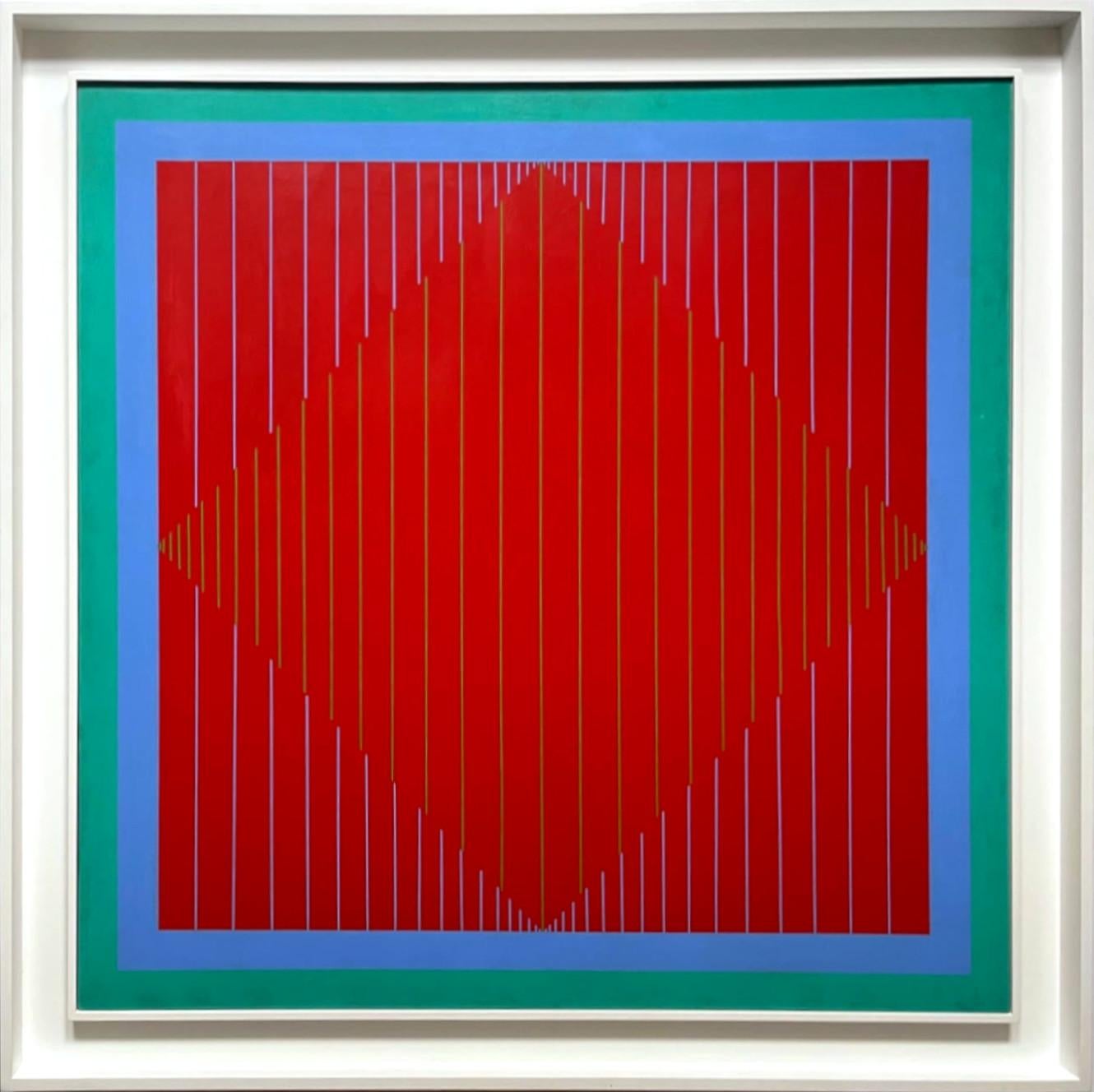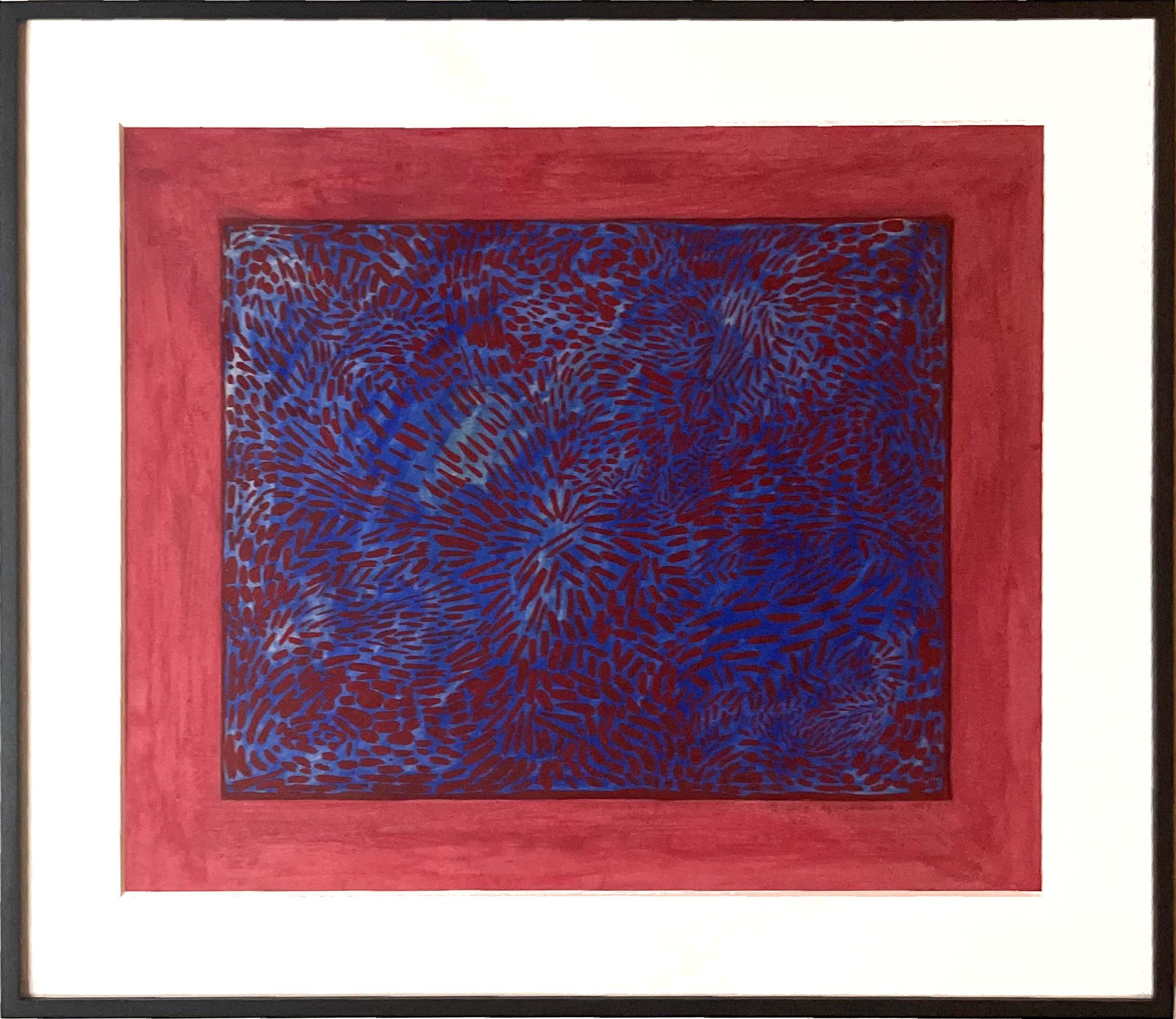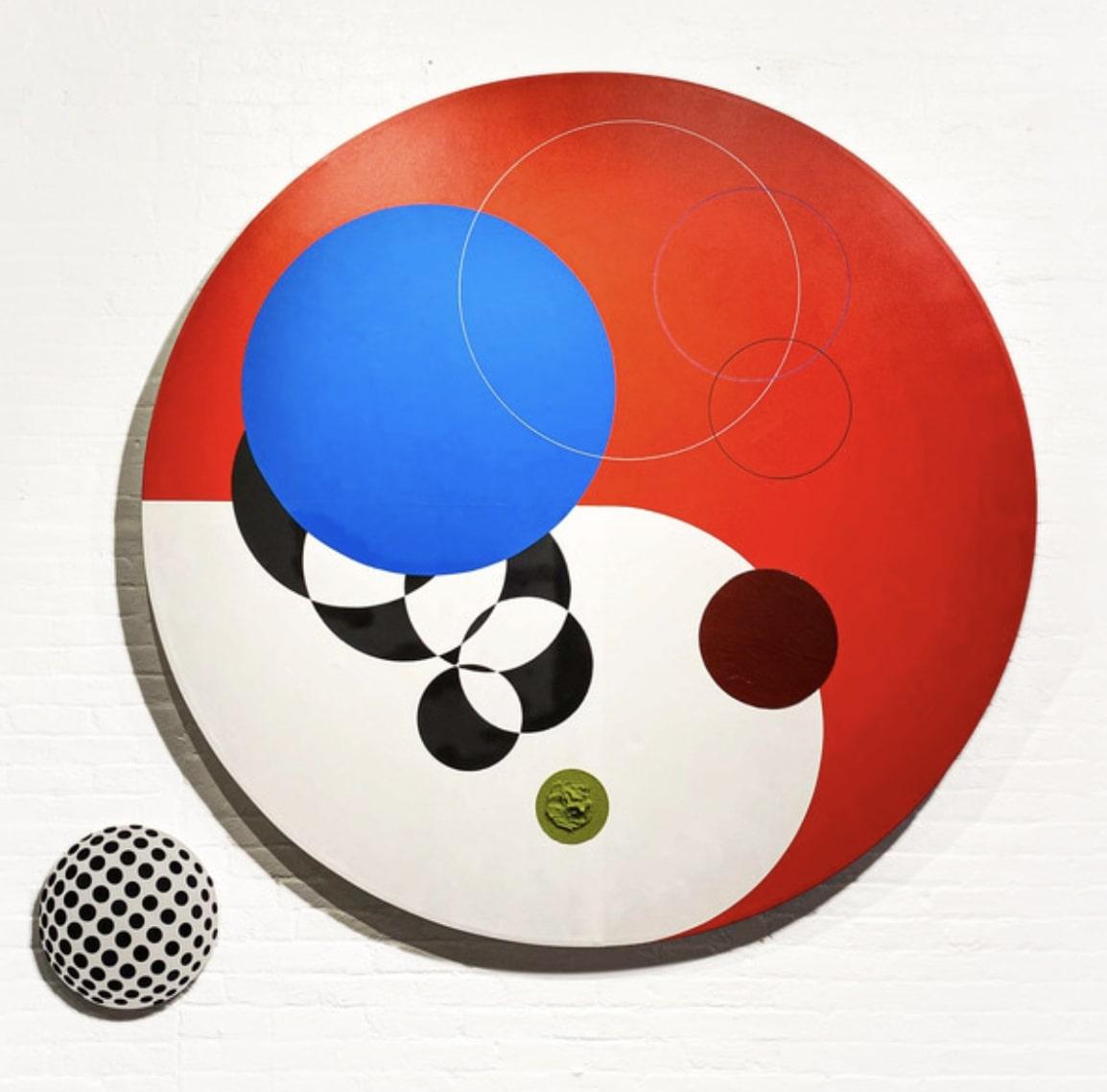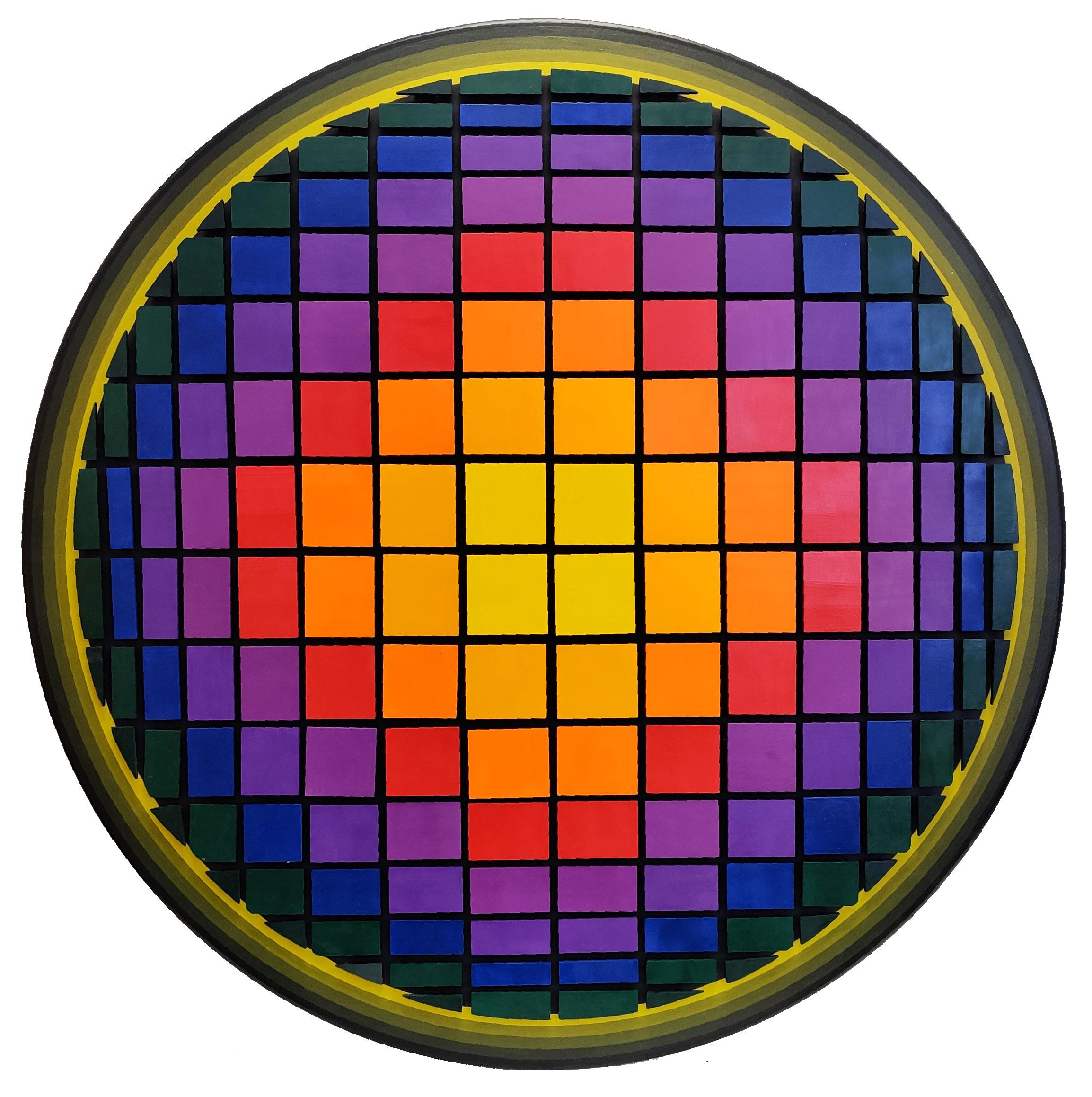Victor VasarelyVintage Chokk Mini C Original Op Art Vasarely Collage Painting
About the Item
- Creator:Victor Vasarely (1906 - 1997, French, Hungarian)
- Dimensions:Height: 24.75 in (62.87 cm)Width: 18 in (45.72 cm)Depth: 1.33 in (3.38 cm)
- Medium:
- Movement & Style:
- Period:
- Condition:
- Gallery Location:Surfside, FL
- Reference Number:1stDibs: LU38210820362
Victor Vasarely
Widely considered the grandfather of Op art, the French-Hungarian painter Victor Vasarely (1906–97) created eye-popping geometric abstractions that play with the viewer’s perception of depth, perspective and motion. A classic example is the 1937 Zebra, which consists of undulating black and white stripes that suggest the form of the titular animal through optical trickery. The work is often credited as the earliest Op art painting.
Such illusions were more than pleasing tricks for Vasarely, who insisted that “pure form and pure color can signify the world.” He wanted to “democratize” art by producing works in large editions at reasonable prices that were understandable across national and cultural boundaries. In the 1960s, he developed an alphabet plastique, or fine art alphabet, consisting of elementary visual building blocks that could be used in endless combinations to create original compositions. By employing this universal visual vocabulary and stripping away topical references, he sought to create what he called a “Planetary Folklore.”
Embodying Vasarely’s singular belief that art should serve a social function, accessible to all, these innovations may perhaps be his greatest contribution to 20th-century art.
Find a collection of Victor Vasarely prints, paintings, sculptures and other art on 1stDibs.
- ShippingRetrieving quote...Ships From: Surfside, FL
- Return PolicyA return for this item may be initiated within 3 days of delivery.
- 1970's Enamel Metal Vasarely Silkscreen Screenprint Axo Kinetic Op Art SculptureBy Victor VasarelyLocated in Surfside, FLVictor Vasarely (1908-1997) Axo This piece is hand signed and numbered circa 1972-1977 I have seen it described as enamel on steel and enamel on aluminium. it is a serigraph on meta...Category
1970s Op Art Abstract Paintings
MaterialsMetal, Enamel
- Israeli 1970s OP Art Kabbala Painting "Jerusalem, 5732" (Star of David) JudaicaBy Yakov KaszemacherLocated in Surfside, FLYa'acov Kaszemacher, well-known artist and photographer whose unique images of Hassidic festivities are fascinating to view, and offer one an opportunity to peek into the community...Category
1970s Op Art Abstract Paintings
MaterialsOil
- Op Art 1971 Kinetic Oil Painting Pop Art ArtistBy Josef LeviLocated in Surfside, FLJosef Alan Levi (1938) is an American artist whose works range over a number of different styles, but which are unified by certain themes consistently present among them. Josef Levi began his artistic career in the 1960s and early '70s, producing highly abstract and very modernist pieces: these employing exotic materials such as light fixtures and metallic parts. By 1975, Levy had transitioned to painting and drawing still lifes. At first these were, traditionally, of mundane subjects. Later, he would depict images from art history, including figures originally created by the Old Masters. Around 1980, he made another important shift, this time toward creating highly precise, though subtly altered reproductions of pairs of female faces which were originally produced by other artists. It is perhaps this work for which he is most well known. Since around 2000, Josef Levi has changed the style of his work yet again: now he works entirely with computers, using digital techniques to abstract greatly from art history, and also from other sources. Levi's works of art in the collections of the Museum of Modern Art, NYC, the National Gallery of Art, and the Albright-Knox Museum, among many others. Levi's art has been featured on the cover of Harper's Magazine twice, once in June 1987, and once in May 1997. Josef Levi received a Bachelor of Arts degree in 1959 from the University of Connecticut, where he majored in fine arts and minored in literature. From 1959 to 1960, he served to a first lieutenant in the U.S. Army, and from 1960 through 1967 he was in the U.S. Army Reserves. In 1966, he received the Purchase Award from the University of Illinois in 1966, and he was featured in New Talent U.S.A. by Art in America. He was an artist in residence at Appalachian State University in 1969, taught at Farleigh Dickenson University in 1971 and was a visiting professor of art at Pennsylvania State University in 1977. From 1975 to 2007, Levi resided in New York City. He now lives in an apartment in Rome, where he is able to paint with natural light as he was unable in New York. From 1959 to 1960, Josef took some courses of Howard McParlin Davis and Meyer Schapiro at Columbia University which initiated him into the techniques of reproducing the works of the Old Masters. His first works, created in the 1960s, were wood and stone sculptures of women. His first mature works were abstract pieces, constructed of electric lights and steel. In 1970, Levi's materials included fluorescent light bulbs, Rust-Oleum and perforated metal in addition to paint and canvas. By 1980, Josef Levi's art had transformed into a very specific form: a combination of reproductions of female faces which were originally depicted by other artists. The faces which he reproduces may be derived from either portraits or from small portions of much larger works; they are taken from paintings of the Old Masters, Japanese ukiyo-e, and 20th-century art. Artists from whom he has borrowed include: Vermeer, Rembrandt, Piero della Francesca, Botero, Matisse, Utamaro, Correggio, Da Vinci, Picasso, Chuck Close, Max Beckmann, Pisanello, Lichtenstein. The creation of these works is informed by Levi's knowledge and study of art history. Josef Levi's paintings from this period are drawn, then painted on fine linen canvas on wooden stretchers. The canvas is coated with twenty-five layers of gesso in order to produce a smooth surface on which to work. The drawing phase takes at least one month. Levi seals the drawing with acrylic varnish, and then he may apply layers of transparent acrylic in order to approximate the look of old paintings. After the last paint is applied, another layer of acrylic varnish is sprayed on to protect the work. Most of the figures in his contemporary pieces are not paired with any others. SELECTED COLLECTIONS MUSEUM OF MODERN ART, NEW YORK, NY ALBRIGHT- KNOX GALLERY, BUFFALO, NY ALDRICH MUSEUM OF CONTEMPORARY ART, RIDGEFIELD, CT NATIONAL GALLERY OF ART, WASHINGTON, DC BROOKLYN MUSEUM OF ART, BROOKLYN, NY SMITHSONIAN NATIONAL MUSEUM OF AMERICAN HISTORY, WASHINGTON, DC CORCORAN GALLERY, WASHINGTON, DC UNIVERSITY OF NOTRE DAME ART...Category
1970s Op Art Abstract Paintings
MaterialsCanvas, Oil
- Modernist Dry Pigment Plaster Lacquer Abstract Geometric Painting Gregg RobinsonBy Gregg RobinsonLocated in Surfside, FLGregg Robinson, American (born 1948) Canvas mounted on wood board work of art depicts geometric shapes and forms with a lacquered high gloss finish. Hand signed lower left and dated 1995. Dimensions: 24 X 24 X 1.75 in. GREGG ROBINSON The universe of visual art encompasses a huge spectrum of motivation and means of expression. Examples range from the most syrupy sentimentality to extremes of moral and intellectual confrontation. For me, the creative process is, on the simplest level, an aesthetic puzzle. Elements of the puzzle include contrast, color, visual texture, graphic pattern, and in some recent work, a simple cryptic symbolism. I have never been particularly interested in lyric or pictorial content, and though some of my work does contain undeniable spatial illusion, even that tends to be a by-product rather than a goal of the primary pursuit: the balance of light and dark, pure color and organic neutrals, energy and calm, strong pattern and subtle field. Having grown up in an environment of contemporary architecture, I have always valued the classic modern synthesis of form and function exemplified by the Bauhaus movement of the early 20th century. Hence, the simplest solutions are often the most satisfying. Obviously, the modernist ideal of efficiency in form and function requires that method of execution be as well adapted to the aesthetic goal as the visual language itself. The media before you is the result of many years of experimentation that came to its current form in early 1992. I work with dry pigment over a plaster surface. My tools are broad knives, sponges, rags and masking. The finish is a high gloss alkyd resin. His prints have been published by GalleryOnline, publishers of Per Arnoldi, Ricardo benaim, Pierre Marie Brisson, Simon Bull, Fanch Ledan, Claude Gaveau and Laurent Schkolnyk and more. SELECT CORPORATE COLLECTIONS: Allstate Insurance NBC Productions Alaska Airlines...Category
1990s Contemporary Abstract Paintings
MaterialsCanvas, Plaster, Mixed Media, Oil, Board, Pigment
- Modernist Dry Pigment Plaster Lacquer Abstract Geometric Painting Gregg RobinsonBy Gregg RobinsonLocated in Surfside, FLGregg Robinson, American (born 1948) Canvas mounted on wood board work of art depicts geometric shapes and forms with a lacquered high gloss finish. Hand signed lower left and dated 1995. Dimensions: 24 X 24 X 1.75 in. GREGG ROBINSON The universe of visual art encompasses a huge spectrum of motivation and means of expression. Examples range from the most syrupy sentimentality to extremes of moral and intellectual confrontation. For me, the creative process is, on the simplest level, an aesthetic puzzle. Elements of the puzzle include contrast, color, visual texture, graphic pattern, and in some recent work, a simple cryptic symbolism. I have never been particularly interested in lyric or pictorial content, and though some of my work does contain undeniable spatial illusion, even that tends to be a by-product rather than a goal of the primary pursuit: the balance of light and dark, pure color and organic neutrals, energy and calm, strong pattern and subtle field. Having grown up in an environment of contemporary architecture, I have always valued the classic modern synthesis of form and function exemplified by the Bauhaus movement of the early 20th century. Hence, the simplest solutions are often the most satisfying. Obviously, the modernist ideal of efficiency in form and function requires that method of execution be as well adapted to the aesthetic goal as the visual language itself. The media before you is the result of many years of experimentation that came to its current form in early 1992. I work with dry pigment over a plaster surface. My tools are broad knives, sponges, rags and masking. The finish is a high gloss alkyd resin. His prints have been published by GalleryOnline, publishers of Per Arnoldi, Ricardo benaim, Pierre Marie Brisson, Simon Bull, Fanch Ledan, Claude Gaveau and Laurent Schkolnyk and more. SELECT CORPORATE COLLECTIONS: Allstate Insurance NBC Productions Alaska Airlines...Category
1990s Contemporary Abstract Paintings
MaterialsCanvas, Mixed Media, Oil, Board, Plaster, Pigment
- Abstract Expressionist 1960s Assemblage Collage PaintingBy Francis JenningsLocated in Surfside, FLHeavily ttextured, layered collaged painting. signed lower right and with a label from American Friends of th Tel Aviv Art Museum verso along with an original label. reminiscent of t...Category
1960s Mixed Media
MaterialsMixed Media
- Metallic Water, unique 1960s Op Art painting (signed), Art Institute of ChicagoBy Richard AnuszkiewiczLocated in New York, NYRichard Anuszkiewicz Metallic Water, 1964 Painting with Liquitex on canvas. (1964 Art Institute of Chicago Exhibition and J.L. Hudson Gallery) Signed boldly and dated 1964 on the ver...Category
1960s Op Art Abstract Paintings
MaterialsMixed Media, Acrylic, Canvas
- Near and Far Acuity, Mid Century Modern Op Art painting from historic exhibitionBy Richard AnuszkiewiczLocated in New York, NYRichard Anuszkiewicz Near and Far Acuity, 1957 Gouache and watercolor painting Hand signed and dated 1957 by Richard Anuszkiewicz on the right front Frame included Anuszkiewicz' artworks from the late 1950s are rarely found on the market. This historic painting is one of the works that helped launch the artist's career. It was done in 1957 - the year the artist arrived in New York. Near and Far Acuity has been removed from its original frame, and re-framed in an elegant wood frame with conservation materials and UV plexiglass. The original gallery label from The Contemporaries has been preserved and affixed to the new backing, and the collector who acquires this work will also be provided with a copy of the original receipt - signed by Karl Lunde (director of the Contemporaries and author of a major monograph on the artist). Measurements: Frame: 32 x 28 x 2 inches Artwork: 21 x 25 inches This work was first exhibited in the groundbreaking, and career-making 1960 exhibition at The Contemporaries gallery (New York, February 29, 1960 - March 19, 1960) and was featured in the exhibition catalogue, shown in the images here. In his essay entitled "Richard Anuszkiewicz: Color Precisionist" by art historian John T. Spike, he writes, "In the spring of '57, Richard Anuszkiewicz left Ohio for good. "I was ready. I came to New York with a substantial amount of work. I was ready to go around to the galleries and I was prepared because I really had something. I had an idea. I had a series of paintings that showed this idea and I felt good about it and I felt now that's the only place for me to be." A friend helped him get a job touching up the plaster models of classical temples and statues in the Junior Museum of the Metropolitan Museum of Art. He took off six months the next year to travel around Europe in a Volkswagen, also seeing some places in North Africa. "When I came back, I remember taking my work around to the galleries and receiving interesting comments — positive comments from the various people. But Abstract Expressionism was very popular. My things were very hard-edged, very strong in color — a use of color that nobody was using. Everybody would say. 'Oh, they are nice, but so hard to look at. They hurt my eyes". Leo Castelli considered him seriously but the gallery was developing a specialization in pop artists like Jasper Johns and Robert Rauschenberg. "I can remember going to Martha Jackson and having her look at the work and she would put her hands straight out in front of her and block out parts of the painting with her hand and she'd say, mmm no rest areas." He finally caught on with The Contemporaries Gallery in the fall of 1959. The gallery at 992 Madison Avenue mainly represented new European talent. Karl Lunde, the gallery director, saw some of his canvases hanging...Category
1950s Op Art Abstract Drawings and Watercolors
MaterialsWatercolor, Gouache, Mixed Media
- Alone in This Together by Andres Ciccone Represented by Prima GalleryLocated in New York, NYAlone in This Together by Andres Ciccone 80 in diameter Acrylic, Ink, Mixed Media, on CanvasCategory
21st Century and Contemporary Op Art Abstract Paintings
MaterialsCanvas, Ink, Mixed Media, Acrylic
- MOON (DIMENSIONAL PIECES OF WOOD WITH MAGNETS)By Stan SlutskyLocated in Aventura, FLOriginal dimensional hand painted wood pieces with magnets attached to circular shaped wood giving illusion of movement.. Hand signed on verso by the artist. Artwork is in excellen...Category
Late 20th Century Op Art Abstract Paintings
MaterialsWood, Acrylic
- Back to the futureBy Ferruccio GardLocated in Palm Beach, FLFerruccio Gard (Italy, 1940) is one of the pioneers and leading artist representatives of the Neo-Constructivist art, Programmed Art and Optical Art, which he has practiced since 196...Category
2010s Op Art Abstract Paintings
MaterialsCanvas, Acrylic
- Sphere 2By Patrice BreteauLocated in Long Island City, NYArtist: Patrice Breteau, French (1942 - ) Title: Sphere 2 Medium: Acrylic on Canvas, signed and dated l.r. Size: 30 x 30 in. (76.2 x 76.2 cm) Frame: 31.5 x 31.5 inchesCategory
1970s Op Art Abstract Paintings
MaterialsCanvas, Acrylic





